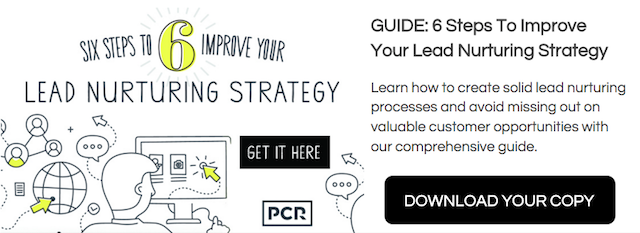
Although most companies now recognize that inbound marketing is an effective promotional tactic, it’s been viewed more often as the icing on the cake rather than a must-have. But even in 2013, 92.7 percent of companies using inbound marketing saw a significant increase in leads.
Since then, more and more companies — from big brands to small businesses — have taken on inbound marketing. And in 2016, inbound marketing is being touted as an essential component to your online marketing efforts. As a result, now is the perfect time to reevaluate your inbound marketing tactics and ask yourself, “Are these really working?”
Why Your Inbound Marketing Isn’t Working
At PCR, I’ve noticed that when companies aren’t seeing success with their inbound marketing tactics, it usually boils down to the same core reasons. Here’s why your efforts may not be working for you.
Download this free guide for even more lead nurturing strategy tips.
1) You don’t know what you’re trying to accomplish
With inbound marketing, a lot of companies dive right into tactics and say, “We need better search engine optimization” or “We need to blog more.” But these companies have yet to take a look at existing assets and how they can be improved before chasing the next big thing in inbound marketing. Plus, these metrics are too vague — you have to align your lead generation with measurable goals to make an impact and analyze results.
2) You haven’t built the right foundation
Around six to 12 months in, if you don’t have a strong foundation on which to build your strategy, your inbound marketing plan can get really messy. You won’t have the proper attribution or reporting, making it hard to scale and see which efforts are going to produce the best results.
3) You don’t have the right person
You may have dedicated someone to “handle” the inbound marketing internally, but it can easily become overwhelming for that person to get up to speed on the right software. Plus, if he or she doesn’t see buy-in or education from the leadership (or isn’t seeing any results fast enough), that person may put undue pressure on the team — or decide to quit altogether.
4) Your inbound efforts are not aligning with your outbound efforts
In my experience, clients can sometimes run print advertisements or pay-per-click campaigns to get more eyes on a certain service or product without any outbound efforts. Landing pages, form capture, or email follow-ups need to be in place to line up with those ads to get the leads you need.
5) Your efforts are not data-driven
It’s understandable for brands to want to stay true to their traditional communication styles. However, not paying attention to important metrics — like whether your open rates are dropping from email to email — can hurt your inbound initiatives. It’s important to hone in on how your users react to certain messaging efforts to develop the right communication.
These aren't the only obstacles that you may be running into, but if you can figure out which one is keeping you from succeeding and address it head-on, then you'll quickly see an improvement in your marketing.
Strengthen Your Inbound Marketing Campaign
Once you’ve identified which pit (or pits) you’ve fallen into, you need to understand how to adapt these marketing mistakes and ensure that they’ll really work. Here are four things you can do along the way.
1) Reevaluate your goals
Ask yourself, “Is this providing value in accomplishing our business goals?” A lot of companies get in “checklist mode,” doing the same thing repeatedly without taking the time to ask whether it’s really working. Remember, goals and objectives — when contingent upon user data — will change and take turns. Scheduling an audit, with measurable goals, every four to six weeks is a good rule of thumb.
2) Communicate with your team
Set up regular check-ins to make sure everyone is on the same page and knows what’s going on. Involve key decision makers in every step of the process. This shouldn’t be done annually or quarterly, but monthly on an ongoing basis. Start with an initial strategic discussion about what really needs to be accomplished to achieve the goals. Perform an existing audit of everything that has been done up to this point, and schedule a time to go through goals of the campaign. Are your expectations realistic?
3) Identify your customer
Build the marketing plan around attracting and engaging these users. You need to know if your inbound marketing strategy will resonate with your ideal customers and help solve one of their problems every step of the way. Make sure your customers are segmented and that you create buyer personas.
4) Measure your data
Data and proper attribution can tell you how effective each campaign is. Measure everything so you’re making educated decisions about its effectiveness. It’s important to at least note a date that you kick off a certain outbound campaign to keep track of internal spikes in website traffic or conversions. Tie all marketing efforts together for tracking, and reporting reasons so you can tell if a campaign is working.
With these four resolutions in mind, you’ll be able to adapt your current inbound marketing strategy to one that works in no time. But as you continue to evolve, you also need to know how to easily find marketing problems before adaptation is no longer an option.
Spotting Those Inbound Marketing Pitfalls
Although we all like to think that we’ll be the first to recognize when we’ve made mistakes, this isn’t always the case. Amid the big rush to “do more” and “do it quickly,” you may neglect the proper steps to build the right type of campaign.
In my experience, companies are having the most trouble identifying their inbound pitfalls because they don’t have the resources to effectively manage them. When brainstorming solutions, I see a lot of companies view a particular type of software or tactic as a cure-all, but that’s rarely the case. It’s often more likely that the marketing team is small and trying to automate their inbound processes from the get-go.
Make no mistake: Automation is great because it leaves the heavy lifting and manual labor to the machines. But over time — if everything is already running on its own — it’s easy to move on to other tasks and neglect actually developing your marketing efforts (especially with one or two people on the marketing team).
Ultimately, identifying these issues involves more than just the marketing team. Teams that are siloed from one another increasingly proves that their differing objectives and lack of communication harm a business across the board. Customer service, sales, and executive leadership all need to be on the same page if the company is going to gain any good leads from inbound marketing efforts.
Often we’re afraid to take a hard look at what we’ve been doing and ask ourselves whether it’s really the best approach to meet our goals. But in 2016, as inbound marketing increasingly becomes a must-have tool in your arsenal, the time is right to collect data, get the right team in place, communicate, and reassess how you reach your leads.




![How to Delete Your Instagram [Easy Guide]](https://blog.hubspot.com/hubfs/delete-instagram.png)
![Millennials vs. Gen Z: Why Marketers Need to Know the Difference [New Data]](https://blog.hubspot.com/hubfs/millenials%20vs%20gen%20z%20what%20marketers%20need%20to%20know%20when%20trying%20to%20reach%20each%20generation.jpg)

![How to Edit a PDF [Easy Guide]](https://blog.hubspot.com/hubfs/280_How-to-Edit-PDF.png)

![Marketing Without a Budget? Use These 10 Tactics [Expert Tips]](https://blog.hubspot.com/hubfs/marketing%20without%20budget.jpg)
